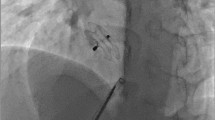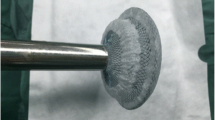Abstract
Aims
Transcatheter closure of secundum atrial septal defects (ASD) with the Amplatzer septal occluder (ASO) has become a standard procedure in most pediatric and adult patients. However, data addressing success rates and outcome in adults is limited. We sought to define the safety profile of the ASO in the community setting and identify the percentage of adults with ASD amenable to percutaneous closure with the ASO.
Methods
We performed a retrospective analysis of patients’ records referred for transcatheter ASD closure from 1999 through 2005 at a single institution. Patients were evaluated with right heart catheterization and underwent closure of the ASD according to standard indications under transesophageal and fluoroscopic guidance.
Results
Two hundred and seven consecutive patients were taken to the catheterization laboratory for hemodynamic evaluation and possible interventional closure of an ASD. Of those patients, 18 were excluded because the defect and the left-to-right shunt were hemodynamically insignificant (n = 7) or because there was no distinct defect, but instead a multi-perforated septum (n = 11). Nineteen cases were excluded for anatomic reasons. Of the remaining 170 patients, ASO implantation was attempted and successfully performed in 166 (83% of 200 patients with hemodynamically significant ASD). Complications occurred in 11 cases (6.5%) (device dislocation = 4, transient ST-segment elevation = 4, TIA = 1, hemoptysis = 1, pericardial effusion = 1); none of these events were associated with long-term sequelae. During a median follow-up period of 13 months (range 6–0) there were no major clinical events.
Conclusions
More than 80% of adults with a distinct, hemodynamically significant secundum ASD can be successfully treated with the ASO. The immediate success rates are excellent and follow-up data suggest that the ASO is a safe device well suited for transcatheter ASD closure.
Similar content being viewed by others
References
Boccalandro F, Muench A, Salloum J, Awadalla H, Carter C, Barasch E, Smalling RW (2004) Interatrial defect sizing by intracardiac and transesophageal echocardiography compared with fluoroscopic measurements in patients undergoing percutaneous transcatheter closure. Catheter Cardiovasc Interv 62:415–420
Butera G, De Rosa G, Chessa M, Rosti L, Negura DG, Luciane P, Giamberti A, Bossone E, Carminati M (2003) Transcatheter closure of atrial septal defect in young children: results and follow-up. J Am Coll Cardiol 42:241–245
Carlson KM, Justino H, O’Brien RE, Dimas VV, Leonard GT Jr, Pignatelli RH, Mullins CE, Smith EO, Grifka RG (2005) Transcatheter atrial septal defect closure: modified balloon sizing technique to avoid overstretching the defect and oversizing the Amplatzer septal occluder. Catheter Cardiovasc Interv 66:390–396
Carminati M, Chessa M, Butera G, Bini RM, Giusti S, Festa P, Spadoni I, Redaelli S, Hausdorf G (2001) Transcatheter closure of atrial septal defects with the STARFlex device: early results and follow-up. J Interv Cardiol 14:319–324
Chan KC, Godman MJ, Walsh K, Wilson N, Redington A, Gibbs JL (1999) Transcatheter closure of atrial septal defect and interatrial communications with a new self expanding nitinol double disc device (Amplatzer septal occluder): multicentre UK experience. Heart 82:300–306
Chessa M, Carminati M, Butera G, Bini RM, Drago M, Rosti L, Giamberti A, Pome G, Bossone E, Frigiola A (2002) Early and late complications associated with transcatheter occlusion of secundum atrial septal defect. J Am Coll Cardiol 39:1061–1065
Du ZD, Hijazi ZM, Kleinman CS, Silverman NH, Larntz K (2002) Comparison between transcatheter and surgical closure of secundum atrial septal defect in children and adults: results of a multicenter nonrandomized trial. J Am Coll Cardiol 39:1836–1844
Du ZD, Koenig P, Cao QL, Waight D, Heitschmidt M, Hijazi ZM (2002) Comparison of transcatheter closure of secundum atrial septal defect using the Amplatzer septal occluder associated with deficient versus sufficient rims. Am J Cardiol 90:865–869
Fischer G, Stieh J, Uebing A, Hoffmann U, Morf G, Kramer HH (2003) Experience with transcatheter closure of secundum atrial septal defects using the Amplatzer septal occluder: a single centre study in 236 consecutive patients. Heart 89:199–204
Ghosh S, Chatterjee S, Black E, Firmin RK (2002) Surgical closure of atrial septal defects in adults: effect of age at operation on outcome. Heart 88:485–487
Hijazi Z, Wang Z, Cao Q, Koenig P, Waight D, Lang R (2001) Transcatheter closure of atrial septal defects and patent foramen ovale under intracardiac echocardiographic guidance: feasibility and comparison with transesophageal echocardiography. Catheter Cardiovasc Interv 52:194–199
Hildick-Smith DJ, O'Sullivan M, Wisbey CR, Mackay JH, Lee EM, Shapiro LM (2004) Amplatzer device closure of atrial septal defects in mature adults: analysis of 76 cases. Heart 90:334–335
Kannan BR, Francis E, Sivakumar K, Anil SR, Kumar RK (2003) Transcatheter closure of very large (> or=25 mm) atrial septal defects using the Amplatzer septal occluder. Catheter Cardiovasc Interv 59:522–527
Khositseth A, Cabalka AK, Sweeney JP, Fortuin FD, Reeder GS, Connolly HM, Hagler DJ (2004) Transcatheter Amplatzer device closure of atrial septal defect and patent foramen ovale in patients with presumed paradoxical embolism. Mayo Clin Proc 79:35–41
King TD, Thompson SL, Steiner C, Mills NL (1976) Secundum atrial septal defect. Nonoperative closure during cardiac catheterization. JAMA 235:2506–2509
Kozlik-Feldmann R, Dalla Pozza R, Romer U, Rampp T, Bernasconi P, Dabritz S, Netz H (2006) First experience with the 2005 modified Gore Helex ASD occluder system. Clin Res Cardiol 95:468–473
Masura J, Gavora P, Podnar T (2005) Long-term outcome of transcatheter secundum-type atrial septal defect closure using Amplatzer septal occluders. J Am Coll Cardiol 45:505–507
Peters B, Ewert P, Schubert S, Abdul- Khaliq H, Schmitt B, Nagdyman N, Berger F (2006) Self-fabricated fenestrated Amplatzer occluders for transcatheter closure of atrial septal defect in patients with left ventricular restriction: midterm results. Clin Res Cardiol 95:88–92
Rashkind WJ (1983) Transcatheter treatment of congenital heart disease. Circulation 67:711–716
Rickers C, Hamm C, Stern H, Hofmann T, Franzen O, Schrader R, Sievert H, Schranz D, Michel-Behnke I, Vogt J, Kececioglu D, Sebening W, Eicken A, Meyer H, Matthies W, Kleber F, Hug J, Weil J (1998) Percutaneous closure of secundum atrial septal defect with a new self centering device ("angel wings"). Heart 80:517–521
Rome JJ, Keane JF, Perry SB, Spevak PJ, Lock JE (1990) Double-umbrella closure of atrial defects. Initial clinical applications. Circulation 82:751–758
Sideris EB, Sideris SE, Thanopoulos BD, Ehly RL, Fowlkes JP (1990) Transvenous atrial septal defect occlusion by the buttoned device. Am J Cardiol 66:1524–1526
Silversides CK, Siu SC, McLaughlin PR, Haberer KL, Webb GD, Benson L, Harris L (2004) Symptomatic atrial arrhythmias and transcatheter closure of atrial septal defects in adult patients. Heart 90:1194–1198
Spies C, Strasheim R, Timmermanns I, Schraeder R (2006) Patent foramen ovale closure in patients with cryptogenic thrombo-embolic events using the Cardia PFO occluder. Eur Heart J 27:258–259
Wang JK, Tsai SK, Wu MH, Lin MT, Lue HC (2004) Short- and intermediate- term results of transcatheter closure of atrial septal defect with the Amplatzer Septal Occluder. Am Heart J 148:511–517
Yew G, Wilson NJ (2005) Transcatheter atrial septal defect closure with the Amplatzer septal occluder: fiveyear follow-up. Catheter Cardiovasc Interv 64:193–196
Zahn EM, Wilson N, Cutright W, Latson LA (2001) Development and testing of the Helex septal occluder, a new expanded polytetrafluoroethylene atrial septal defect occlusion system. Circulation 104:711–716
Zanchetta M, Rigatelli G, Pedon L, Zennaro M, Carrozza A, Onorato E (2005) Catheter closure of perforated secundum atrial septal defect under intracardiac echocardiographic guidance using a single amplatzer device: feasibility of a new method. J Invasive Cardiol 17:262–265
Author information
Authors and Affiliations
Corresponding author
Rights and permissions
About this article
Cite this article
Spies, C., Timmermanns, I. & Schräder, R. Transcatheter closure of secundum atrial septal defects in adults with the Amplatzer septal occluder: Intermediate and long-term results. Clin Res Cardiol 96, 340–346 (2007). https://doi.org/10.1007/s00392-007-0502-3
Received:
Accepted:
Published:
Issue Date:
DOI: https://doi.org/10.1007/s00392-007-0502-3




